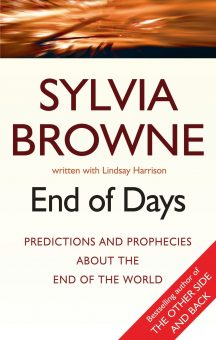I can tell you with psychic certainty that the landscape of this planet at the end of days will be the same continents we have now, each of them severely diminished by flooding. Two- thirds of the earth is currently covered by water. By the end of this century, water will cover three-quarters of the planet as ice caps, glaciers, and snow from the highest mountains continue to melt. Most of the melting ice will flow into the oceans, drowning coastal cities and driving the population toward the middle of the continents. What doesn’t melt into the seas will seep into the earth, to its red-hot core, creating steam and pressure, which will in turn cause a rash of catastrophic volcanoes around the world. Mount Lassen, Mount St. Helen’s, and Mount Aetna will be among the first to erupt, but even the dormant Mount Fuji will come to life again no later than 2085, decimating much of Japan.
Contributing to the atmospheric violence of the last three decades of this century will be an array of weather extremes that will make our current climate look ordinary. Hurricanes and monsoons will more than double in frequency and intensity. The average heat and cold record temperatures throughout the world will be a minimum of ten degrees hotter than they are now. Tornadoes will become destructive year- round threats, rather than seasonal, throughout the central North and South American continents and in areas of Europe and Africa once thought to be topographically immune from them. And where flooding isn’t prevalent, drought will be, so that it will become virtually impossible to find a healthy, profitable place to live, let alone a safe one.
Yes, all thanks to global warming. So how dare any of us ignore it or trivialize it, when it’s literally the difference between life and death for humankind.
A major contributor to global warming is the infamous “greenhouse effect,” a term we’ve heard so often that I’m not sure we even pay attention to it anymore. And believe me, we need to. I certainly don’t pretend to have a background in science or the slightest bit of expertise, but as I understand it, the greenhouse effect is caused by atmospheric gases, particularly carbon dioxide, methane, and ozone. (At ground level, ozone is a polluting form of oxygen.) They retain and reflect the sun’s energy back to Earth to keep us warm. If it weren’t for the basic greenhouse effect, this planet would probably be nothing but solid ice.
The danger we’re increasingly creating is really an enhanced greenhouse effect, in which too much carbon dioxide, methane, and ozone are filling the air, so that too much energy from the sun is being retained and reflected back to Earth, with the result that we keep on getting warmer and warmer. So a key to the solution to global warming is the reduction of the amount of carbon dioxide, methane, and ozone we’re allowing to be released into the atmosphere, through the burning of fossil fuels like coal and oil, for example. And eliminating vast areas of trees and other foliage dramatically compounds the problem, since plants take in carbon dioxide and give off oxygen—helping to reduce carbon dioxide from the air without our having to lift a finger, in other words, and further rewarding us with oxygen, without which we cannot survive.
Ozone as a pollutant at ground level is obviously not to be confused with the essential ozone layer, which forms a thin shield in the upper atmosphere that protects life on Earth from the sun’s ultraviolet rays. As far back as the 1980s, scientists began gathering evidence that the ozone layer was being depleted, exposing us to potential radiation and the related possibility of skin cancer, eye damage, and harm to the immune system. NASA has even begun monitoring holes in the ozone layer—commonly called holes but actually specific areas of extreme thinning or depletion.
And in this case the primary culprit is CFC—a man-made gas called chlorofluorocarbon—which for decades was popularly used in spray cans and refrigerators. In the year 2000, 120 countries around the world agreed to phase out the use of CFC. Sadly, while the ozone layer is capable of repairing itself if no further harm is inflicted on it to exacerbate the damage, the healing process is guaranteed to be very slow. Chlorine, which is one of the components of chlorofluorocarbon, has amazing durability in the atmosphere, and it just takes one atom of chlorine to destroy one hundred thousand molecules of ozone.
Pages: 1 2 3 4 5 6 7 8 9 10 11 12 13 14 15 16 17 18 19 20 21 22 23 24 25 26 27 28 29 30 31 32 33 34 35 36 37 38 39 40 41 42 43 44 45 46 47 48 49 50 51 52 53 54 55 56 57 58 59 60 61 62 63 64 65 66 67 68 69 70 71 72 73 74 75 76 77 78 79 80 81 82 83 84 85 86 87 88 89 90 91 92 93 94 95 96 97 98 99 100 101 102 103 104 105 106 107 108 109 110 111 112 113 114 115 116 117 118 119 120




